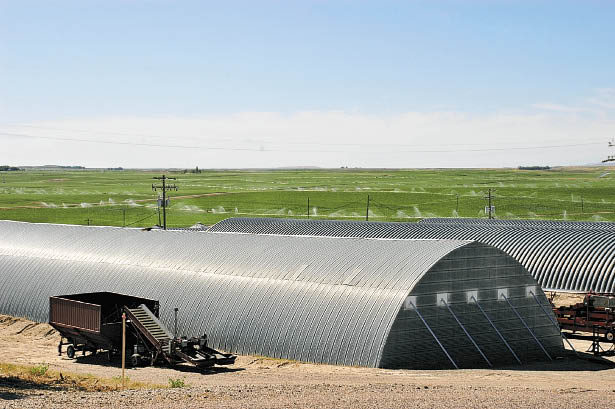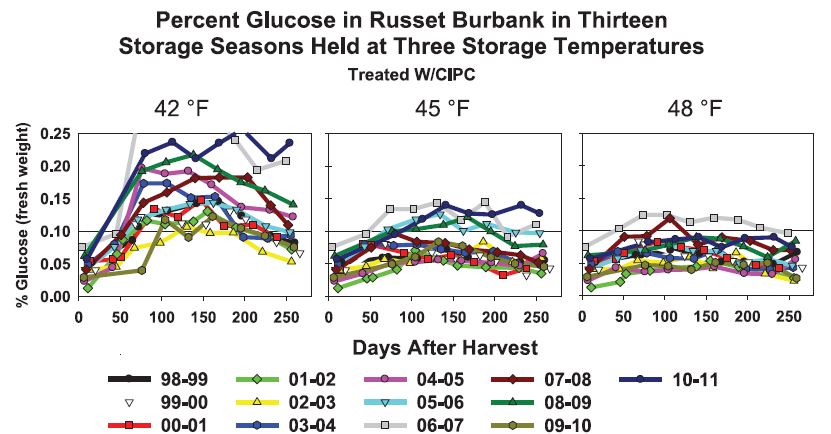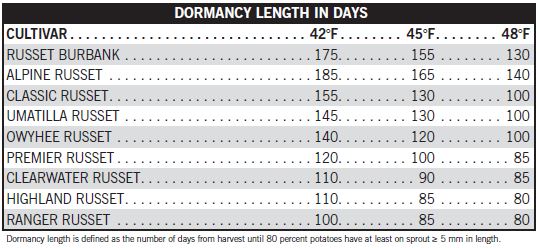
Potato growers have many potential marketing avenues including process, fresh, dehydrated and combinations of two or more. Storing potatoes for these multiple uses presents some unique challenges due to the quality concerns each market presents. Included in the quality concerns are disease, shrink (weight loss), pressure bruise, sprouting, sugar accumulation and overall quality.
Reducing Sugar Content
Generally speaking, the colder the storage temperature for the potatoes, the greater the accumulation of reducing sugars and thus darker fry color. However, there are several factors that influence sugar content of a potato, including variety, growing season, vine kill and harvest and storage. Within early storage management, there are items such as holding temperature, duration and ventilation, and finally transport and handling at the retail end.
The exposure of potatoes to cold temperatures may lead to higher sugars (reducing). In 13 years of research growing Russet Burbank potatoes at the Kimberly R&E Center, sugars at harvest have varied more than six-fold. The 13-year mean glucose was 0.044 percent, the maximum was observed in 2006 at 0.076 percent and the minimum was 0.013 percent in 2001 (Figure 1). In general, glucose levels below 0.1 percent are acceptable for french fry processing quality, whereas levels of 0.2 percent or below are needed for quality dehydrated products. It is not always possible to control all situations that occur in the field, but it is important to know that the status of the crop will vary from year to year.
Even when grown under the same field conditions, varieties can vary in glucose concentrations at harvest by five or more times; however, often sucrose concentrations may be the same. This is an example of inherent differences in sugar metabolism among potato varieties. These differences at harvest can be managed somewhat by storage temperature. In general, if you select a 48-degree F storage temperature, you will see smaller differences in glucose concentrations between varieties throughout the storage season. By contrast, if you store at 42 degrees F, the differences among the varieties in terms of glucose may be exacerbated (Figure 2).
In the case of some varieties, a few degrees colder in storage temperature can result in a crop becoming off-grade for processing. At 45 degrees F, Classic Russet maintained glucose concentrations less than 0.10 percent throughout nine months in storage, while at 42 degrees F, glucose concentrations reached 0.2 percent by about 90 days after harvest (dah). The potatoes at 45 degrees F met the glucose standards for frozen processing while the ones at 42 degrees F did not.
Another example in the sensitivity of a potato variety to storage temperature was shown in November 2005 in samples of Russet Norkotah stored at three temperatures. At 45 degrees F, glucose concentrations were 0.1 percent, at 42 degrees F glucose was 0.15 percent, and at 39 degrees F glucose was 0.6 percent (on a fresh weight basis) in Russet Norkotah. The three-degree temperature drop from 42 to 39 degrees F increased the glucose concentrations by 400 percent, while the three-degree temperature change from 45 to 42 degrees F increased the glucose concentration by only 150 percent.
Some varieties of potatoes are more tolerant to cold temperatures. For instance, in 2002 Alturas glucose concentration increased from 0.05 percent fwt at 48 degrees F to 0.15 percent fwt at 42 degrees F after 180 dah. In Teton Russet, glucose concentrations increased 800 percent between 48 to 42 degrees F after 180 dah in 2010.
Diabetic Test Strips
It is important for suppliers of potatoes to fresh-cut fry restaurants to be aware of the glucose concentrations of their potatoes in order to provide potatoes that will make an acceptable fry. One project recently conducted at UI Kimberly was to evaluate diabetic test strips and blood glucose meters for use in potato testing.
Glucose results from two test kits-Accu-chek Active and OneTouch Ultra-Mini-were compared to results from the same tuber using a laboratory standard Yellow Springs Instrument (YSI) sugar analyzer. Results from both meters had a strong correlation to the YSI values, meaning that it is possible to use blood glucose kits to determine general glucose levels in potatoes.
To use the diabetic kit to test a potato, the disposable test strip is simply inserted into the meter and then gently pressed against a slightly macerated tissue portion of a cut tuber to allow it to come in contact with the juice of the macerated tissue. There must be sufficient liquid, or the meter will alert you of an error. The meter provides a displayed value that is used for the "x" value in the equation below. Test near the center of the potato since glucose concentration may vary in different parts of the tuber. Test several tubers for an average glucose level in a given lot of potatoes. If you want to test for the highest level, this value is often seen at the stem end of the potato.
To convert the value from the glucose meter to percent glucose on a fresh-weight basis, replace the "x" in the equation below with the meter value.
Accu-check = 0.000705x + 0.00453 OneTouch=0.000741x - 0.00713
For example, if the value on the glucose meter after the strip-contacted potato juice was 150, multiply 0.000705 times 150 and add 0.00453, which equals 0.110 percent glucose (1.1 mg/g glucose) on a fresh-weight basis if using the Accu-check meter. If using the OneTouch meter, multiply 0.000741 times 150 and subtract 0.00713, which equals 0.104 percent glucose.
General recommendations of storage temperatures for specific cultivars and end-use categories can be made based upon data produced through research projects. In general, for dehydrated process potatoes, store Russet Norkotah, Russet Burbank and Teton Russet at 45 degrees F. Alturas may be stored a few degrees cooler, but it may vary with the year. Take into consideration if it was a potentially stressful year.
For french fry process potatoes, Russet Burbank should be stored 45 to 48 degrees F. Alturas can be stored at 45 degrees F. It is important to know that storing at higher temperatures comes with consequences, such as greater sprouting, disease and shrinkage potential.
In a study conducted at the Kimberly Potato Storage Facility with Premier Russet potatoes, lower Fusarium dry rot was observed in potatoes stored at cooler temperatures. Premier Russet potatoes bruised and inoculated with Fusarium had 57 percent disease incidence when stored at 42 degrees F, compared to 69 percent when stored at 45 degrees F.
Severity was also higher (41 vs. 23 percent) in the 45-degree F stored potatoes versus the 42-degree F potatoes. In studies with Russet Norkotah silver scurf-infected tubers, there were no significant differences observed among the storage treatments of 40, 42, 45 and 48 degrees F in percent incidence of silver scurf after five months of storage.
A few degrees difference in storage temperature may not be as critical with that particular disease, but can make a significant impact when pink rot, Pythium leak or late blight is present. If wet rots are present, remove field heat as rapidly as possible, cure potatoes at 50 degrees F and store at the lowest holding temperature acceptable to maintain quality.
Dormancy length is influenced by storage temperature. In general, the colder the potatoes are stored, the longer the dormancy of the potato (Table 1). In Russet Burbank, the average dormancy length at 42 degrees F is 175 days, at 45 degrees F it is 155 days, and at 48 degrees F it is 130 days. Dormancy length also differs for each potato variety. For instance, Ranger Russet has a shorter dormancy length, at 42 degrees F it is 100 days, at 45 degrees F it is 85 days, and at 48 degrees F it is 80 days on average.
Weight loss is another factor that storage managers must be aware of and try to minimize. There are inherent differences in weight loss among potato varieties. In general Russet Burbank, along with Ranger Russet and Western Russet, are among the varieties with the lowest weight loss in storage. Varieties with moderate weight loss (1.1-1.9x that of Russet Burbank) are Alpine Russet, Classic Russet, Clearwater Russet, Highland Russet and Owyhee Russet. Premier Russet has a high degree of weight loss (>2x that of Russet Burbank) in storage. Being aware of weight loss potential of the potato variety is important for making storage management decisions such as duration of storing. Storing at lower temperatures may lower weight loss potential.
Storage managers must decide to which markets they intend to sell their stored potatoes in order to make the best management decisions for that crop. The chief concern for a storage manager is to deliver the highest quality possible to buyers. Included among the quality concerns are disease, shrink, pressure bruise, sprouting, sugar accumulation and overall quality. Sugar accumulation is a concern not only for french fry and chip processing but also for fresh-cut fries and dehydrated product as well. Understanding the interaction of storage temperature and variety on storage issues along with knowledge of crop growing conditions, disease susceptibility, dormancy length and weight loss is key to successfully managing quality in storage.


